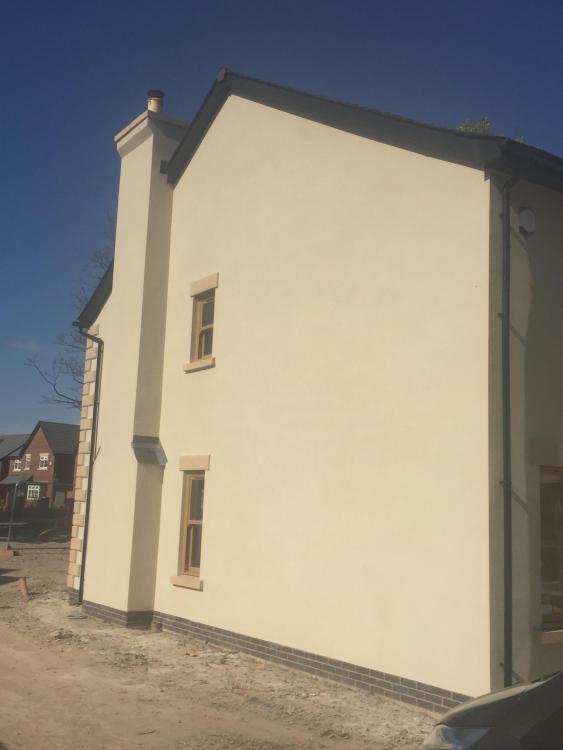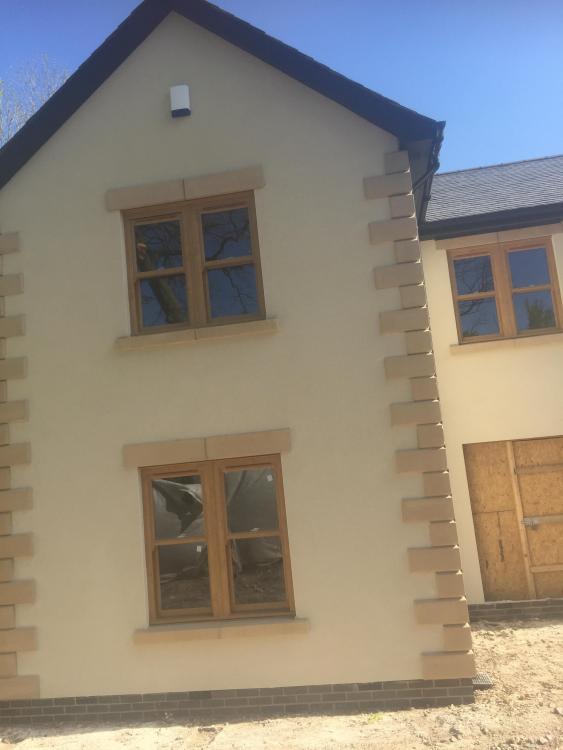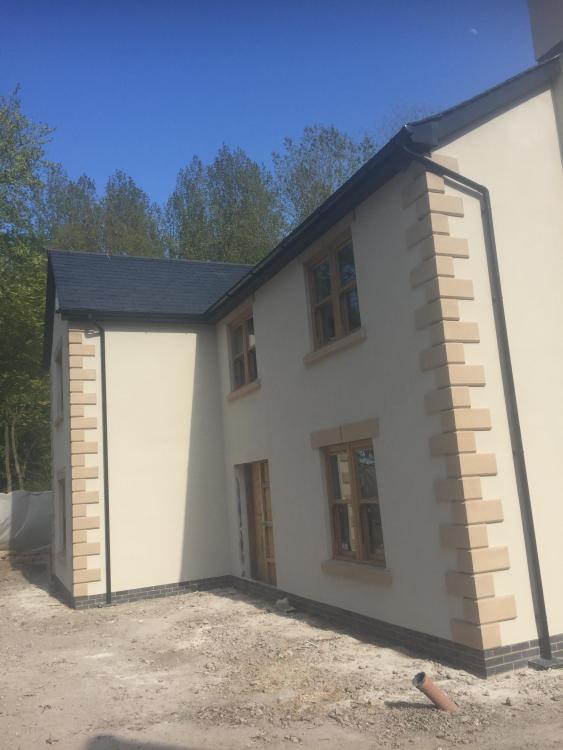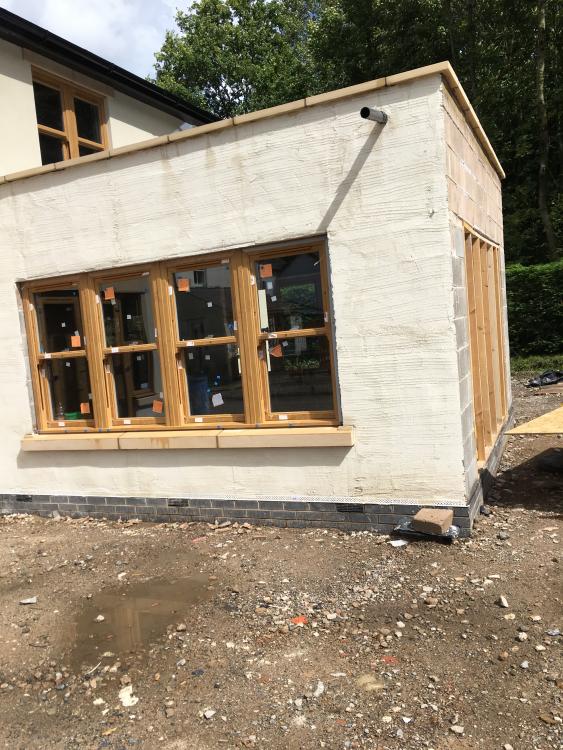Leaderboard
Popular Content
Showing content with the highest reputation on 11/15/17 in all areas
-
2 points
-
Don’t go too cheap I've been doing these type of render systems for over thirty years We are not particularly expensive But have been undercut by as much as 50 % on some jobs Dave is very near the mark with a £100 per sq mtr you're going to be looking at it for a long time This is the house that I’m self building. Two of us, four and half days applying two coats of k rend 300 bags Last March2 points
-
1 point
-
I started off with near-zero knowledge about this, but was spurred into having to do something when Ebuild went down, taking a lot of the most useful blog content with it (all the attachments and photos were made inaccessible when it was made read-only). Like an idiot, it hadn't occurred to me to make a back up.......... There followed a fairly frantic few days where I and a few here who kindly helped me out managed to scrape most of the content from the Ebuild server, although it was incomplete, because there were only broken links to the photos and attachments. I then rebuilt every blog entry, one by one, as a set of documents, with the attachments and photos as links to where they were locally stored (and backed up). I was very firmly convinced that the only way to keep things safe was to go for a paid for hosted service. I chose Fasthosts, for no other reason than they were already looking after my domain registration and providing me with a handful of email accounts on that domain. I wasn't using the web space associated with that domain name at all, it was just sitting idle. I had no idea as to how to use Wordpress, or set it up on a server, but managed to get it running locally on my own PC after a bit of playing around. This was a nice and safe way to experiement, as if it all went horribly wrong I could just delete it and start again, without having to deal with something on a remote server somewhere. There are some good guides for doing this on the web, and if using Windows there is a package available that allows you to fairly easily set up a local environment that behave like a remote server. After playing around for a time, and transferring my old blog documents to Wordpress blog entries OK, I felt reasonably comfortable with transferring these across to a bit of paid for webspace (not expensive, I think I paid around another ten pounds a year on top of the email hosting and domain name renewal fees I was already paying for. Then this forum came to life, and the blog function was activated, so to help kick start things here I but my own blog on hold for a while and copied everything across to here. Sadly I ended up getting some abuse and ended up locked out of that blog when I took a break from posting here for personal reasons, associated with stress (and I wasn't the only founder member to take a break at this time, either, setting this place up and building a house was tough for a time). For reasons I to this day don't fully understand, I ended up getting some abuse and effectively being locked out of the blog here when I returned, so I then had no real choice but to get on and go back to the original plan, of putting everything on my own web space using Wordpress. That turned out to be very easy, as the hosting company have an automatic set up option that does practically everythign for you. All you need to do is choose a theme and write (or copy) the content across. You also need to remember to back it up, as blogs hosted on any webspace, anywhere, are not backed up for you as a rule. There are some easy to use back up tools available in for Wordpress, and generally they do a basic back up to your home PC, or some other storage, OK, but none of them seem that comprehensive. Havig had two experiences where I risked losing control of content I'd written (and I can't access or edit my blog here, as it's locked, for example, and a lot of it is now out of date, where I've edited errors in the live version and added some new content over the past year). I've become a bit paranoid, and have spent more time learning how to make a full backup. I now have an exact mirror of my blog running here at home on a Raspberry Pi, plus the same Raspberry Pi has incremental back ups of everything on the hosted server, taken every night, just to be safe. Once a week I copy the latest back up to another hard drive as insurance, too! Based on my unfortunate experiences, I'd probably avoid the "free" Wordpress, Blogspot etc offerings and opt to pay a small fee to host your own website. Not only can you run multiple blogs for different family members, but you can also use it for file storage. I keep a few handy files stored on mine, that I can access using FTP from pretty much anywhere. It's not ultra secure, but none of the files are sensitive, they are things like calculation utilities I've written, that are handy to access easily, a bit like some of those I've added as downloads to the top of my blog front page, for others to download and use.1 point
-
@Russell griffiths What approvals are you going to need exactly? I would say that there's a bit more scope for the use of innovative or unusual materials within the Building Regs system than there is if you are having to satisfy the requirements of a warranty company or mortgage company surveyor, however when it comes down to it I'd agree with @curlewhouse - the only way of guaranteeing compliance is to appoint your BCO early on in the design process and then open a dialogue with them about the materials you would like to use. Normally it doesn't cost any extra to appoint a BCO early in the process but I'd be upfront with them if you think that you will need a lot of input from them at the design stage - after all you will need their cooperation in the process and if they haven't budgeted for the required time they may not work with you in the way that you need.1 point
-
I don't know the answer to your question, but this is where I get my advice from The employee who answers the phone (perhaps used to now) seems(ed?) to have an encyclopedic contacts list. She listens well.1 point
-
From a conversation I had yesterday with the engineer of the firm who are overseeing our warranty, I'd definitely talk to your BCO first before parting with your cash once you've identified which you want to import- a throwaway remark I was told yesterday during a prolonged conversation (covered in another thread) was that if for example I'd got our SIPs panels from Sweden they'd (the warranty firm) "just walk away", having come across some unsatisfactory ones presumably.1 point
-
@Redoctober, you have five decisions to make. Hosting Volume of information you want to publish Blog platform Data security Domain name Hosting: you can disappear under the weight of guff written. Answer the next three questions and then decide the host Volume: text only, but video and photos hosted elsewhere (YT Vimeo FB} ? Or everything on your space? Video eats space, images too Platform: WordPress, but look at the smaller ones Security: EMEA Domain: purchase your own, or do you mind being part of a subdomain? ( redodoctober.wordpress ) Cheap, cheerful: sub domain at wordpress. Balanced cost with security, look at @TerryE or @JSHarris or @ProDave 's example. Once you get one you'll want to add bells and whistles.1 point
-
I suppose the cat was a living demonstration of the principle of staying active.1 point
-
I am a bit of an old stick in the mud. I don't see much wrong with conventional controls. I have never felt the need to turn my heating on and off remotely (and even less so in the new house that uses so little heat) I once asked someone exactly why they wanted to do this. The slightly sarcastic reply went something like "It allows someone with the latest phone on an expensive monthly contract, to buy the latest expensive control system, so that when the train home from their long commute to their well paid job is late, they can turn the heating off to save a few pounds of gas."1 point
-
+ several million for this. The less you move the faster you deteriorate when you get older. I've been doing a lot of reading about exercise and older people (partly for my parents in law, partly because I'm no longer that young myself). I found this to be an excellent book, but the short version is that it's never too late to start exercising. Most importantly, as you get older, you should focus on activities that build muscle (ie, strength training) rather than doing cardio.1 point
-
Woke up this morning in our new home! Now sat on the sofa watching tv in my new home, waiting for a full day of rugby TV to start so I can sit and sip cold beers in my new home! Can you tell I’m pleased?! Facts and Figures 1 year, 1 month, 14 days (Breaking Ground to Moving in) 4 Double Bedrooms 3 Ensuite 1 Family Bathroom 1 WC Open plan lounge kitchen diner Utility Room Double Garage Workshop Land: £120k Build Cost: £200k Size: 300m2 Cost per m2: £666/m2 (This figure is slightly off as a large part of my ground floor is garage / workshop space so can’t really be counted as fully costed m2. However I’ve also got a £30k retaining wall in the ground floor section that wouldn’t usually form part of the cost per m2. Either way I think I can happily say I’ve built for approximately £800/m2 which I’m very pleased with) Photos below of all the finished areas. Garage and outside space an ongoing project!1 point
-
There are loads of ways of demonstrating compliance, but you often need to do a fair bit of work to track down enough information to keep BC happy. Bear in mind that, as mentioned above, what we loosely refer to as the "building regulations" are really the Approved Documents that suggest some ways that the building regulations may be complied with - the Approved Documents are not the regulations, just guidance, in effect. For example, for structures, then Approved Document Part A gives guidance based on standard details that are known to be OK, but equally you can use very non-standard details (like our passive slab, that sits on load-bearing expanded polystyrene) and show that this meets the regulations themselves. In that case demonstration of compliance with the regulations was by a structural engineer's report, plus the specifications for the EPS, concrete floor and steel reinforcement. When designing light aircraft (a hobby job I had for a time) I constantly had to battle a similar problem. The UK CAA has a set of regulations, and a set of guidance documents, that are exact parallels to the way the building regulation system works, but maybe a couple of orders of magnitude more comprehensive. I regularly had to show that materials and components imported from other countries, that did not have a recognised UK CAA or EASA (the European equivalent of the CAA) approval were OK. Sometimes this was easy - for example AISI material specifications ( the US standard) often had a near-enough direct read across to European or UK standards. An example would be that the common US structural light alloy, 6061-T6, was accepted as being equivalent to the far more common in the UK 6082-T6 alloy. Sometimes I had to go back to basics, and compare tests showing material properties undertaken in another country with tests that would be more normal in the UK. The most challenging job I did was convert all the data for a Hungarian aircraft design (before Hungary was in the EU) into the equivalent UK spec - it involved a fair few hours translating Hungarian to English and convincing a UK CAA surveyor that the materials used were equivalent to UK materials. I doubt that there will be any significant problem if you are importing building materials from anywhere within the EU, as they will almost certainly have some form of specification and certification that can be read across. There are a lot of agreements in place to accept certification from other countries as being equivalent to BBA. For example, the Irish certification scheme, NSAI is almost always accepted as being OK in place of BBA certification (just as well, as our entire house and garage only carries NSAI certification for all the structural materials!). You may need to provide evidence to show things like this, though - our building inspector wasn't aware of the read across from NSAI to BBA, for example, until I pointed it out.1 point
-
Are you building the Empire State Building? Concrete Cube tests a year later? I've have given them a big F and O! That was one reason we avoided Warranty - we don't need one as we'll be there fore a long time and are building it 'properly' but it's just an extra level of grief - as you say, what if they are not satisfied? Bonkers! Since this morning I've arranged to meet my BCO onsite next week to talk through what he wants for temporary Habitation Certificate. I hope he's happy with what he sees - no going back now!1 point
-
To answer some basics, the Sunamp is fine with pre-heated water. It delivers water at around 75 deg C when charged, and the amount of hot water you get out depends on the temperature that the Sunamp has to raise the water by. If you feed it with water at 30 deg C, say, and you set the Sunamp TMV to 45 deg C (the delivered DHW temperature) then it only has to raise the water from 30 deg C to 45 deg C, in effect, so will deliver twice as much hot water on a charge than if it was fed with water at 15 deg C. Our cold water comes in at around 8 deg C, all year around, but mains can vary from around 4 deg C to 8 deg C with the season, I believe, The thermal store thing is only a problem in this application because thermal stores are intended to operate at high temperatures, much higher than an ASHP could deliver. The design temperature for most is around 75 deg C, so with hot water coming out of the thermal store TMV at 45 deg C, and a 5 deg C temperature loss across the coil in the thermal store (perhaps a bit on the high side) then the thermal store can deliver hot water at a constant temperature to the DHW system until it cools down to below about 50 deg C, and then the temperature will start to drop. For pre-heat, then the thermal store temperature will start to drop immediately, as it's already below the DHW temperature, which is why a UVC would be a better bet. If I get time later I'll do some example calculations and perhaps a graph that illustrates how a low temperature UVC compares to a low temperature thermal store when used as a pre-heat system. Right now I keep popping in here as a break from sorting out hundreds of receipts and filling in our VAT reclaim...............................1 point
-
EPS is specific in that it refers to Expanded PolyStyrene foam, but it comes in a wide range of densities and compressive strength ratings. The number after "EPS" gives the compressive strength for 10% compression (too much "give" for a foundation) in N/mm², so EPS70 (the very light packaging type foam) is 70N/mm² at 10% compression, whilst the strongest stuff around is probably EPS300, at 300N/mm². Some types have additives mixed in before the foam is steam blown, like graphite, which can improve the thermal properties and change the colour (this is often what makes some foam look grey, or have grey speckles in it). It's all the same stuff though, in the sense of being the same type of plastic beads foamed in the same way with steam, that both creates the foam and bonds the beads together into a solid block.1 point
This leaderboard is set to London/GMT+01:00

.jpg.c21f3ac78c9b7efd90cbdcb312744dc5.thumb.jpg.7adcad4c0e384f5ecd7d56b0618df6e5.jpg)








